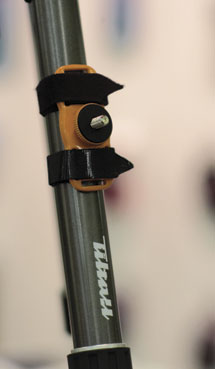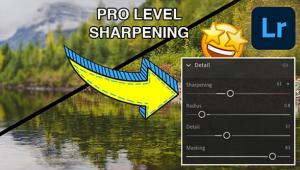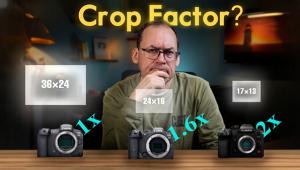Shutterbug’s Exclusive photokina Coverage; Tripods And Camera Supports: A Sampler Of A Prolific Field Page 2
Aluminum remains popular, too, for high strength at low cost, at a modest weight penalty. Davis & Sanford introduced the Voyager 3H: only 21” long collapsed, but with a maximum height of 58”, while their ProVista Grounder, designed for videographers, goes very low to the ground. Manfrotto also introduced a new low-cost M-Y series for the first time tripod buyer, offering good quality at a reasonable cost. This is a useful alternative to poor quality at low cost (“it would be cheap at half the price,” as the saying goes) or top quality at top cost (which beginners, especially, may be unwilling to pay). Manfrotto reckons that once a beginner sees the difference a decent tripod can make, they’ll be hooked and may go on to greater things (and tripods).
As already noted, many manufacturers offer parallel models in both aluminum (strictly, of course, aluminum alloys) and carbon fiber, and one manufacturer that particularly caught my eye was Induro, now imported to the US by MAC Group. They make both alloy and carbon-fiber tripods with both three- and four-section legs and it would be interesting to test four (two alloy, two carbon fiber) side by side, comparing lighter weight and faster set up (three-section) or compactness (four-section) and actual weight differences, as well as a check on relative vibration deadening between the three- and four-section legs for the two alloy and two carbon-fiber tripods; that could go either way.
Then there are wooden tripods. The only manufacturer I saw at the show who is still making a wide range of wooden tripods under their own name was Berlebach. The Berlebach stand is always very distinctive because the tripods they show are all in natural ash, though they also offer a choice of natural or stained wood. I’d love a red wooden tripod: wonderfully distinctive as well as very practical (hard to lose!). As well as a new line of chairs (honestly—see later), Berlebach also had a new mini tripod with a leveling bowl. HP Marketing Corp. distributes Berlebach in the US.
Or how about plastic beads? At least, that’s what they look like, though in fact they are a lot cleverer than they look: gorillapod’s new heavy-duty Focus (capacity: 5 kg/11 lbs) uses machined aluminum sockets in the “beads.” The tripod itself weighs just 500 g/18 oz and maximum height is 289mm, just under 12”. If you aren’t familiar with the gorillapod design visit their website at www.joby.com. Joby donates 1 percent of their sales to saving nature.
Another flexible-leg mini tripod is the FlexPod Gripper from Sunpak. It comes in a rather unlikely pink as well as blue and black. Legs are thermoplastic with an aluminum core and include self-leveling feet; they carry a quick-release ball head.
Heads, Brackets, And Panoramas
What sort of tripod head you like best is a very personal matter: a combination of how you work, and how your mind works. Every year there are updates and redesigns, and although the new heads may not look very different, the changes can be remarkable, especially among ball-and-socket heads. There are, after all, usually good reasons why one ball-and-socket head costs $40 while another costs $400.
Gitzo’s newest offering even looks different: a lightweight magnesium housing with an offset ball—which, for “added lightness,” has been hollowed out. These heads are very light for their load-bearing capacity and have variable drag, so you can set the resistance for your needs.
Some of the big ball heads from FLM look unusual, too, as they have up to five (!) adjustment knobs: lock, drag, rotation, pan, tilt. This makes the heads incredibly versatile, but you need to be sure that your mindset is in tune with that of the designer. FLM products are distributed by Omega Satter.
One FLM head even comes with the revived Ideesign Q-Top head as standard. These superb small, light but alarmingly expensive quick-release-cum-panoramic heads ceased production some years ago but have how been reintroduced by Monochrom in Germany; no American distribution yet, but they don’t weigh much, so if you’re desperate, mail order from www.monochrom.com.
Panoramic photography can be fascinating. Many tripod heads have 360? markings to help you keep track of what you are doing. A number of companies have panoramic plates that go between the camera and the tripod head, with click stops (like the Q-Top) for more precision and control. The highest level of precision and control is provided by panoramic brackets. Several manufacturers make these, but Novoflex upgraded two they introduced at last photokina (one is now optimized for fisheye) and introduced a third, a complete new professional system. As each of these brackets does different things it is best for you to study the details on their website.
QRs and panoramas aren’t the only accessories that were introduced at the show. Some were quite minor, but invaluable if you need them. For example, the simplest accessory came from Tiltall. It is a small curved plate with a tripod screw on it, and it attaches to one leg of any tripod (or a bicycle top tube, or any straight tube of similar dimensions) with touch-fastener-type hook-and-loop straps. A high-hysteresis rubber pad on the inside stops it sliding or rotating. Tiltall tripods are distributed in the US by Brandess-Kalt-Aetna Group (BKA).
UNI-LOC changed the way that their flash bracket attaches, so that it now fits their bigger tripods. Benbo has a new center column adapter which can be retrofitted to the Trekker, allowing you to lock up the “drunken octopus” legs and still move the center column independently. And for their new UNI 82-89 range of tripods, Berlebach introduced a leg tie set as an alternative to the length of lavatory chain traditionally favored by photographers to stop legs splaying too much, as well as accessory stainless steel foot spikes.
Which reminds me: most top-flight, well-established manufacturers offer reparability and the possibility of upgrades. Tripods last halfway to forever but accidents do happen: I know of one assistant who drove a truck over a Linhof tripod… Check the manufacturers’ websites to see if they offer spare parts, or have a service department.
Photographer Supports
In the studio or in the field you sometimes need to sit down. You may need to wait for a particular shot; or to sit and think; or just to sit; or to look at a computer screen, which I for one find to be less enjoyable than just sitting.
Walkstool makes very light folding three-legged stools with triangular sling seats, in several heights; the latest is the tallest. As well as resting the weary photographer, they make excellent posing stools because the design makes the sitter sit up straight. They are distributed in the US by BKA.
 |
|
|
For a seat that is pretty, practical, and portable, look at Berlebach’s Observers chairs. There are three models, the Nix, the Hydra, and the Charon. They were designed as astronomy accessories, but they would make good posing stools as well as photographers’ chairs, being attractive, light, strong, and easy to unfold and fold up.
 |
|
|
As I said at the beginning, there have been monopods, bipods, tripods, and now QuadroPods. What is left? Well, antigravity, maybe. As one manufacturer said, with regard to overseas markets, “I really must get these tripods off the ground.” I look forward to visiting his stand at photokina 2010…
- Log in or register to post comments

































